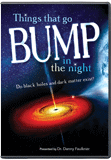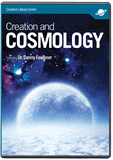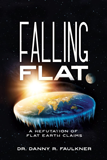Mulling Over the Multiverse
The multiverse is the stuff of superhero stories. But some scientists think this comic-book cosmos could explain the origin of our universe. Can Christians be sure the multiverse is no more than science fiction?
“How many Flashes are there? One? Two? Is Barry Allen the real Flash? Or is Jay Garrick? Does the Flash live in Central City? Or in Keystone City? Only one thing seems certain! Both live on the Planet Earth! And only by traveling to that ‘other’ earth can the Flash discover his alter ego and become the . . . Flash of Two Worlds!”
—1961 DC Comic Book
The notion of parallel or alternate universes fires the imagination. It’s no wonder that this plot device has spawned science fiction stories, comic books, movies, and TV shows, starting with the 1961 DC comic book Flash of Two Worlds. Offering an even more tantalizing vehicle for storytelling is the multiverse, a collective of infinite number of universes. For years, Hollywood has hitched its star to this storytelling staple, from Star Trek to The Twilight Zone, from Spider-Man: Across the Spider-Verse and the aptly named Dr. Strange and the Multiverse of Madness to this summer’s DC film The Flash.
However, before fictional superheroes jumped universe to universe, the multiverse was devised in scientific conversation. Indeed, some scientists continue blending fiction with reality by entertaining the concept of the multiverse in serious scientific discussion. But is there any physical or scientific justification for the multiverse? And how did such a far-out concept change scientists’ belief that our universe is the only physical reality?
The idea of the multiverse might have arisen to negate the need for an origin of the universe—and with it an ultimate designer. Ironically, however, the notion of the multiverse actually increases the demand for a Creator who specifically designed the one and only earth to host life.
The Change
The universe coming into existence from nothing presents many scientific and philosophic problems for naturalistic scientists who are devoted to denying God’s existence. For much of history, scientists and philosophers believed the universe is eternal with no beginning. After all, a universe with no beginning sidesteps the question of who created it.
Then came the 1965 discovery of the cosmic microwave background (CMB).
What in the World is the CMB?
The Cosmic Microwave Background (CMB), a field of radiation in the microwave section of the light spectrum, encompasses our universe. In 1965, radio astronomers Robert W. Wilson and Arno A. Penzias discovered the CMB by accident. Wilson and Penzias were attempting to measure radio waves from galaxies beyond our own, but their radio telescopes were disrupted by hissing static. The static was caused by radiation, but they were able to rule out noise, fallout from nuclear detonations, and even pigeons nesting in the equipment. After a year of experiments, Wilson and Penzias realized they had unwittingly discovered the CMB. In 1978, they won the Nobel Prize in Physics for their finding.
Before the discovery of the CMB, scientists and philosophers had long believed that the universe is eternal, with no beginning. The big bang model, however, predicted the CMB two decades before it was discovered. Therefore, the CMB has been accepted as the best proof of the big bang, and thus the big bang model became the dominant cosmological theory for the origin of the universe. But a closer look reveals that the CMB actually creates problems for the big bang model.
So what do creationists believe about the origin of the CMB? Further work is needed within the creation model, but the CMB might be radiation from the waters in the expanse God made on day two of creation week (Genesis 1:6–7).
Whatever the explanation for the CMB, we can be sure it agrees with the Genesis account in God's Word.
The big bang model had been predicting the CMB for two decades, but eternal universe theories had not. Consequently, the belief in an eternal universe rapidly eroded, while the big bang model soon reigned as the dominant cosmology. The big bang model posits that the universe began with the sudden appearance of space, time, matter, and energy in a hot, expanding state. Over the ensuing 13.8 billion years, the universe supposedly expanded and cooled into the universe that we see today.
As early as the 1950s, scientists came to understand that the universe appears designed for our existence. For instance, if the fundamental constants of nature, such as those governing the structure of the atom, were only slightly different, then life would not be possible, and we wouldn’t be here contemplating the universe. In 1973, the theoretical physicist Brandon Carter coined the term anthropic principle to describe this apparent design in the universe. If the big bang were a one-time event, doesn’t the apparent design for our existence make the universe very improbable? Wouldn’t that logically lead to the conclusion that there is a Designer who created the universe? For those committed to naturalism, that was a most unpalatable reality.
In 1985, astronomer and cosmologist Edward R. Harrison offered the multiverse to naturalists as a way out of this conundrum. He summed up his proposal very succinctly: “Take your choice: blind chance that requires multitudes of universes, or design that requires only one.”
Suppose universes exist without number, with new universes popping into existence all the time. Universes that host life require numerous specialized qualities. If universes are randomly generated, then most universes would be sterile, without life. But life might develop in those rare universes where life is possible. Hence, we shouldn’t be surprised to find ourselves living in a universe that appears designed for our existence. In other words, after enough sterile universes had popped into existence, our universe won the lottery with everything randomly falling into place to host life.
At some point, Harrison’s solution to the problem posed by the anthropic principle had quite an impact. After Harrison’s suggestion, popular books about big bang cosmology began mentioning the multiverse, and from there, this imaginative concept began to find its way into entertainment.
Big (Bang) Problems
The big bang model posits that the universe began billions of years ago in a tiny, hot, dense point containing all mass, energy, and space. Over time, the universe expanded and cooled into everything we see today. But there are big problems with the big bang, rendering it entirely implausible. Here are just a few.
Missing Monopolesis
Physicists propose that the heat from the big bang should have created monopoles (a large particle like a magnet but with only one pole). However, monopoles have never been found. This suggests that the universe was never very hot to begin with, and thus no big bang.
Too Little Antimatter
As the universe supposedly expanded after the big bang, the energy would have created matter (hydrogen and helium gas). However, experimental physics reveals that energy that creates matter also produces antimatter with reversed particle charges. If true, the big bang would have caused an equal amount of antimatter and matter. But we see only a trace amount of antimatter in the universe today.
The Horizon Problem
The horizon problem is a light travel time issue with the big bang model. Evolutionists can’t explain why different portions of the CMB have the same temperature, despite those portions not having had time to enter thermal equilibrium. Though scientists argue that inflation in the early universe explains this away, they have no proof.
Not Seeing Stars
The big bang model can account only for the existence of the lightest elements—hydrogen, helium, and trace amounts of lithium—leaving heavier elements unexplained. Evolutionary astronomers claim that stars produced these other elements through nuclear fusion. First-generation stars should then be comprised of only the lightest elements, since only these elements would have existed originally. But we don’t find any such stars. All known stars contain at least trace amounts of the heavier elements.
But Was It Science?
Do scientists have physical justification for the multiverse? Many scientists think so.
Do scientists have physical justification for the multiverse? Many scientists think so.
In 1905, Albert Einstein established the equivalence of matter and energy in his famous E = mc2 equation. According to his theory, the universe appears to be governed by the conservation of mass/energy. But the sudden appearance of matter and energy supposedly instigating the big bang would violate the conservation of mass/energy, meaning the universe came into existence in a manner inconsistent with itself. In the 1970s, American physicist Edward Tryon offered a way out of this dilemma.
The Uncertainty Principle
One of the twin pillars of modern physics is quantum mechanics, the physics of small systems, such as subatomic particles. In quantum mechanics, things we think of as being particles, such as protons and electrons, are best described as waves. Particles can be localized—we can establish their positions very precisely. But waves are extended objects—can we say exactly where a wave is located? Is the wave located at the wave’s peak? Is it at the wave’s lowest point? Or is the wave located at some sort of average point? Consequently, in quantum mechanics there is an inherent fuzziness in the world. This is not just a matter of inability to measure things precisely; it is a fundamental uncertainty built into the universe. Physicists call this the uncertainty principle.
One manifestation of the uncertainty principle is that there is uncertainty in simultaneously knowing the energy of a particle and the time the particle was observed. If we know the energy of a particle very well, then we don’t know the time the energy exists very well. On the other hand, if we have precise knowledge of the time, then the energy of the system is not known precisely. This is a fundamental uncertainty, not merely an uncertainty in measurement—even if we had infinite precision in our measurements, this uncertainty would remain.
One application of the uncertainty principle is to allow for small temporary violations of matter/energy conservation, with matter/energy popping into existence and then quickly disappearing. The greater the conservation of matter/energy violation, the shorter the time the violation can exist. These quantum fluctuations have been invoked to explain many phenomena, such as some encountered in modern electronics. Some cosmologists view the entire universe as a quantum mechanical system, subject to the uncertainty principle. If the energy of the universe is exactly zero, then it is argued that the universe could have popped into existence as a quantum fluctuation.
“Our universe is simply one of those things which happen from time to time.”
But is the energy of the universe exactly zero? The universe is filled with energy in the form of matter and light, so there would have to be an equal amount of negative energy to exactly balance this positive energy. Tryon noted that gravity provides negative potential energy, and asked what if the negative energy exactly cancels the positive energy so that the energy of the universe is zero? He reasoned that treating the universe as a quantum mechanical system with zero energy, the universe could have come into existence in the finite past as a quantum fluctuation that has persisted for billions of years. That way, the universe could have come into existence in a manner that is consistent with itself. In his paper announcing his theory of the universe’s origin in 1973, Tryon wrote that “our universe is simply one of those things which happen from time to time.”
Tryon’s proposal has been criticized by some as a misunderstanding of the uncertainty principle, while others have pointed out that there is no evidence that the energy of the universe is zero. Despite these objections, Tryon’s proposal has much support among scientists today. Tryon was primarily thinking of only our universe’s origin, but his reasoning easily can be used to argue for the existence of other universes as well. For instance, quantum fluctuations may continually arise in our universe, birthing new universes. Presumably, our universe began as a quantum fluctuation in another universe that formed long before our universe did.
Many Worlds Interpretation
Another route to the multiverse comes from a quirky part of quantum mechanics. Quantum mechanics uses the wave function to describe particles, such as electrons. The wave function is a formula for predicting a particle’s location or movement. It is a probability function, indicating where the probability of finding a particle is high or low. When many particles are considered together, the experimental results are consistent with the particles acting like waves—more particles end up where the probability is high, and fewer particles show where the probability is low. However, when individual particles are observed, they don’t act as waves—they act as particles, assuming definite states.
With origins in the late 1920s, the Copenhagen interpretation is the most common understanding of this odd behavior. According to the Copenhagen interpretation, a particle behaves as if it is a wave, simultaneously existing in all possible states (and no states!) until it is observed. The act of observation collapses the wave function, with the particle assuming a definite state. While most physicists subscribe to the Copenhagen interpretation, many physicists find it unsettling, so they have searched for other interpretations.
In 1957, the American physicist Hugh Everett published his many worlds interpretation of quantum mechanics. Unlike the Copenhagen interpretation, Everett viewed the wave equation as being very real, the consequence being that when a particle is observed, rather than the wave function collapsing, the different probabilities of the wave function of that particle play out in different worlds, or universes. In this way, every quantum mechanical possibility is played out in some universe. Hence, new universes are continually spawned by our universe, as our universe was born from some other universe. For instance, I usually wear whatever my wife lays out for me. Today she laid out black slacks and an olive polo shirt, so that is what I am wearing while I type this. But she could have picked any number of other ensembles for me to wear. So there must be several other universes where I am typing away on this article while wearing entirely different clothes. Or perhaps there is a universe where I am wearing what I am wearing right now, but I’ve decided to watch a cat video on the internet. I hope that my boss in that alternate universe doesn’t find out! Or maybe in that alternate universe I am the boss. The possibilities are endless.
When Everett proposed his many worlds interpretation, it was met with little enthusiasm. That lack of support probably stemmed from belief in an eternal universe. However, after the big bang model became popular, interest in Everett’s approach grew, for it offered a vehicle to the multiverse.
Science—or Science Fiction?
Note how the thinking has progressed. For centuries, scientists thought that the universe was eternal. An eternal universe solves the problem of how the universe came into being for those who don’t want to acknowledge a Creator. However, once scientists embraced the big bang model in the 1960s, the need for the universe to have a beginning arose, along with theistic implications of a beginning. The multiverse solves the problem of the universe having a beginning, and in its own subtle way, is a return to an eternal cycle and to atheism. The difference is that each universe need not be eternal since universes can be born and die. It is the multiverse that continues indefinitely into the past and into the future. But since we cannot observe this activity, the multiverse theories lie in the realm of speculation, not science.
Scientists discussing a topic doesn’t make the topic science.
Scientists discussing a topic doesn’t make the topic science. For instance, the late paleontologist Stephen Jay Gould was a fan of baseball and often wrote about baseball, but that didn’t make baseball science. Science is the study of the natural world using the five senses—but we can’t study other universes with our senses. The universe is the totality of physical existence, but even if other universes existed, they would not intersect or interact with our universe. If they did, they would be part of our universe, not separate universes. In other words, I would never cross ways with the Danny Faulkner wearing bib overalls and a straw hat.
Since we can’t interact physically with other universes, the multiverse cannot be science. Certainly, scientists may use scientific principles, such as those of quantum mechanics, to muse about the possibility of other universes, but that is more like science fiction than science—comic book fodder not cosmological fact. That these atheistic scientists are willing to entertain such fantastical, unscientific speculations such as the multiverse represents the lengths they will go to explain away the Creator.
Strange Faith
In the Marvel universe, Dr. Strange ominously observes that "frighteningly little" is known about the multiverse. The fictional doctor’s statement reveals the reason why most scientists reject the notion of a multiverse: a lack of evidence. In fact, those who do embrace belief in the multiverse exhibit something akin to faith—the very thing they scoff at.
Physicist Paul Davies, in his New York Times article “A Brief History of the Multiverse,” stated, “Invoking an infinity of unseen universes to explain the unusual features of the one we do see is just as ad hoc as invoking an unseen Creator. The multiverse theory may be dressed up in scientific language, but in essence, it requires the same leap of faith.” Of course, Davies doesn’t acknowledge that faith is also required to believe that the cosmos burst into existence with a big bang. As with all conversations around origins, the multiverse requires faith either in God’s Word or a fabricated explanations for how the cosmos began.
Ultimately, the concept of a multiverse merely multiplies the “God problem” for naturalists. No matter how they try to spin the multiverse into existence—whether through quantum fluctuation or the many worlds cosmology—they all require some sort of origin story with a designer who set the process into motion.
The Gospel Truth
Though alternate realities make for a mesmerizing fictional backdrop, the multiverse’s atheistic undertones should steer Christians away from entertaining this fantasy as reality.
According to Genesis 1:1, God created our one and only universe in the finite past, so we know the universe had a beginning. According to 2 Peter 3:10–13, the universe will have an end, to be replaced by a new heaven and new earth—a new universe.
It is a reasonable scientific conclusion that the universe is designed. Even secular scientists acknowledge that.
It is a reasonable scientific conclusion that the universe is designed. Even secular and atheist scientists acknowledge that. Why else would they invoke the multiverse as a solution to a problem that they don’t think exists? This illustrates the truth of Romans 1:19–22 which tells us that the world itself testifies that there is a Creator, leaving humans without excuse. But rather than responding to that truth, humans in their lost state become futile in their thinking, and their foolish hearts are darkened to the truth of creation and God’s existence.
God created only one earth, and in six days he designed that earth ideally suited for life of all sorts, including humans created in his image. But God’s care went far beyond that. We are all sinners whose disobedience separates us from God. In his love for us, the Creator of the universe provided a way of salvation for all men through the work of his Son, Jesus Christ.
We will never experience the enthralling strangeness of meeting another "us" on a different planet. Instead, we get to take part in something far more magnificent: to know and glorify our Creator on our one earth. That’s not science fiction. It’s the gospel truth.
Answers Magazine
October–December 2023
The Rocky Mountains are a majestic reminder of God’s past judgment and future promise.
Browse Issue SubscribeRecommended Resources

Answers in Genesis is an apologetics ministry, dedicated to helping Christians defend their faith and proclaim the good news of Jesus Christ.
- Customer Service 800.778.3390
- © 2024 Answers in Genesis







